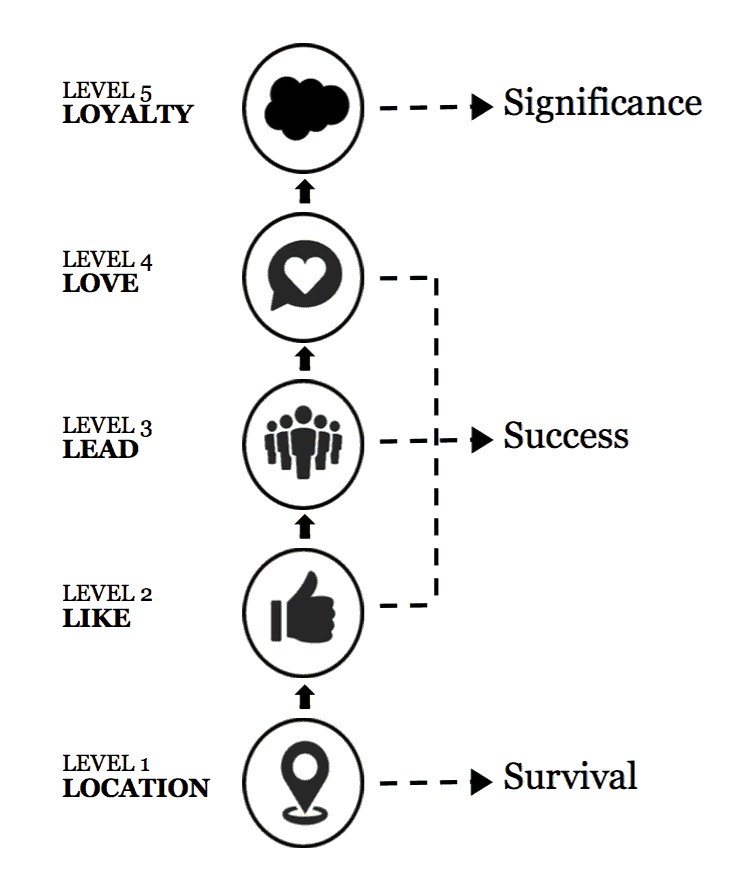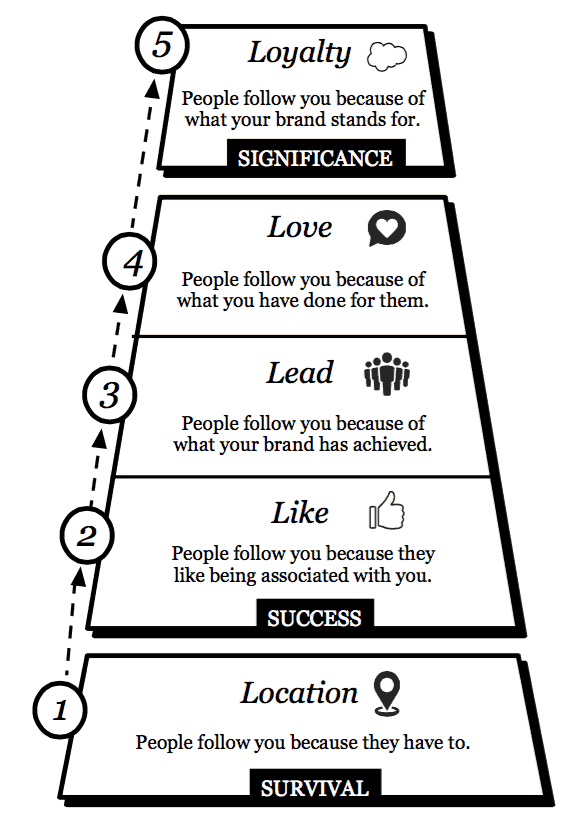
How can your brand go from survival to significance? I asked this and other strategic brand questions to Jeremy Waite, author of Survival to Significance and Head of Digital Strategy, EMEA, and other strategic brand questions about this and other strategic Cloud.
You can listen to the audio podcast on iTunes and Soundcloud (embed below) or keep reading for an abridged conversation transcript. Questions by yours truly, answers by Jeremy.
What are the five levels of brand leadership?
The book came about by accident. I read an awful lot, and I love to read magazines. I read maybe a book or two a week and I watch a lot of TED talks and Bloomberg and a lot of stuff that we both enjoy. And one of the things that I was seeing was there was always a lot of talk about leadership, and it was about personal leadership, and you’ve got all these coaches that are trying to help you be better in your professional and personal lives. But not as many people talked about brand leadership. What does that mean? How do you get a brand to be better than it is? And at what point do you achieve success or anything more, and how do you measure that? Some people have been trying on social media for years, right?

Jeremy Waite
I was listening to people like Rick Warren, who wrote Purpose Driven Life. I talk a lot about purpose-driven brands that we’ll come to later. Leadership coaches like John Maxwell, a great leadership guy, a New York Times best-selling author, has written a ton of stuff, about 85 books or so, and he talks about personal leadership, as well. And as I started thinking about this, it was like, well, there probably are these three levels that brands go through when they’re trying to succeed. They start off in survival mode, and then they become successful when they try and figure out what it is that they do. Then, they put all the metrics in the right place. They create good content. They speak to their customers in the right way. They start to get sales in order and measure it correctly.
And then, some brands, the very few, may achieve a level of significance where they stand for something more than themselves. And that’s where you have these ridiculously loyal brands like Toms, Patagonia, and that stuff. So, I talk about that in the book. But basically, what happened is I started to break this down. The book was just going to be a whole load of blog posts tied together. I just thought it’d be fun, right? I like creating stuff. I really just wanted a nice hardback book that I could give to my mum. And this is like all of my favorite articles all in one place. As I started piecing all of these things together, I noticed that every brand that I’ve worked with and studied over the last sort fifteen or eighteen years has gone through a similar process. Some go through that process a lot faster than others. Some don’t always go from survival to success to significance. They go from survival to success, to survival to evil survival, and then to significance. I mean, Apple Mac is a great example, right? They were about three months away from bankruptcy, not long before they asked Steve Jobs to return.
So as I started doing this, I thought maybe there’s a story in this that’s not been told before. And maybe there are levels of leadership that apply to brands that could apply to companies that in the past we only thought applied to people. So I started mapping all of this down and categorizing all the different blog posts, all my favorite stories, and my favorite authors. And I noticed that there were precisely five. So, I started to build those out about a year ago.

Jeremy Waite
This isn’t like where they follow you because they like you on Facebook or they follow you on Twitter. They may be your favorite football team, it might be your favorite fashion brand, or your favorite actress or sports star. This is where there’s a genuine connection because you love them because of what they’ve done for you. And you can do all of that on your own. This is where you start to measure customer satisfaction; you’ve got people like KLM that do incredible customer service and great experiences; they’re measuring everything correctly, NPS customer service resolutions. And that’s about as good as you can get on your own. Now what happens is there’s a level above that, but companies can’t get there on their own by putting in a good strategy or buying expensive technology. You can only get that by your customers putting you there. And I believe that’s a level of significance where you’ve got a cause or a belief.
The location level is level one. The like level is level two. The leadership level is level three. You’ve got level four, which is all about love. The other level, level 5, is about loyalty, where most case studies happen when we talk at conferences. We see the blog posts written about this, which is what Zappos did, and this is what Southwest did. And we’ve heard the same case studies a million times. That’s all a level of success. Many people don’t discuss the level above where you genuinely have some mission or cause.
Is there a recipe for becoming a brand that puts purpose before profits?
So I don’t think it’s a step-by-step guide because once you talk about profits with a purpose, that has to be embedded within the company’s culture. You can’t just say, and a great example might be a brand that says, “Right, we’re going to attach ourselves to this charity, and we’re going to have this initiative, that we’re going to go out and support schools.” And it’s almost a very transactional view. Let’s attach ourselves to a cause because it looks like the right thing to do. And that’s CSR. A lot of CSR policies are like that. What I’m trying to talk about is there has to be a giving mentality that’s completely different. So it’s not so much that you’ve got a step-by-step guide because, really, that’s what CSR policy is. How do we figure out what it is that we’re doing to make the world a better place and be responsible and all that sort of stuff? And it’s exciting stuff, and we should all do it. But I think a level above that has to come from the founder.
So whether or not, you know, even from Patagonia, you’re talking about, let’s give 10% of revenue, or 1% of profits, whichever is greater, and we’re going to donate all of that to outdoor charities that we believe in. Whoever he invests in, usually some kind of local charity around the mountains and stuff, the outdoor brands he works with. In the 1-1-1 model, Marc Benioff gives away 1% of product, time, and equity. And that came right from day one when the company was set up. That wasn’t an initiative that we thought, well, we’ll do that because it’s cool, and we’ve got a whole bunch of money. If we’re going to make a lot of money, we need to ensure that as we scale, our giving can also scale. And the reason I ended up write the book when I was looking into it. And I’m not, you know, Charles Best from Donors Choose says, “If you give away one dollar, you’re a philanthropist.” And I think there’s this misconception that philanthropists must be like Warren Buffet or George Soros and have billions of pounds before you’re a philanthropist. You give away one dollar to the guy on the street, and you’re a philanthropist.
The issue with businesses is that you can look at philanthropy.org, and there’s a whole load of sites where you can go find out these stats, but of all the money given in the world to do good stuff, only 5% of it is given by companies. And of the 5% companies give, 80% of that is given away for tax reasons because it makes sense to do that because you can offset your tax against corporate giving and stuff. But that leaves a very, very, very small percentage of brands saying we want our profits to have a purpose.
What brands are significant and doing it right?
I used the; it’s kind of a really cheeky idea of an example, Levi Strauss, one of the biggest jeans brands in the world, one of the best socially connected brands, colossal company, doing incredible stuff, patented the denim and riveted the jeans together. He didn’t want to do that in the beginning. He didn’t want to make a ton of money, even though he left his family and moved over to San Francisco in the middle of the gold rush in the early 1900s. He wanted to invest in universities, scholarships, and orphanages. And he was like, “How can I do that? Well, how about if I set up a business?”
Then he saw people’s pants were ripping when they put their axes and stuff in it. So he buys this new tent material, he makes this thing that ends up being denim, and then they figure out that they can rivet them together because they start to become torn. And his friend says, “We can patent this, but I’ve got no money.” And he says to Levi, “You’ve got a bit of money because you’ve got a camping shop even though you’re not selling that much stuff. Do you want to pay for the patent? We’ll split it 50/50.” Levi’s Jeans are born. Now Levi has started to give away a ton of money, and they’re doing amazing things. And it came from the fact that he wanted to make profits with a purpose, but his purpose came first.
So now my challenge is if you’re making a ton of money, fantastic. You need to put those principles in place. But you’ve got to make sure it’s authentic, and your intent is correct. But the brands doing the best stuff like Toms, Patagonia, Levi’s and, Salesforce, even Nike, when you look at their foundation stuff, it happened on day one because their company was built on a purpose, and they knew what they stood for. And everything was secondary. I believe, provocatively, many people disagree with me on this; I believe Facebook’s precisely the same. There’s a reason why Zuckerberg’s investing so much money into internet.org. It makes no commercial sense whatsoever for Facebook to do that now. Transactional brand, short-term money, keeps stakeholders happy. The two-thirds of the world, that internet.org is trying to connect, are not going to spend any money on advertising, they’ve got no data plans. He’s trying to make people access Wikipedia by floating drones and giving Wi-Fi to everyone or seeing a farmer who can check your stock price and make more money to support his community. And that isn’t a financially driven incentive; we just want to connect the world to make it a better place. And we can be cynical, as we should be, because it’s Facebook, but again, I don’t think stories like that get told often enough. And I don’t believe people like Zuckerberg and internet.org get enough credit for that sort of stuff.
Connect with Jeremy on Twitter @JeremyWaite.
- Tagged With:
- Branding
- Brands
- Salesforce
STAY CONNECTED.
DATA-DRIVEN EMPLOYER
BRAND INSIGHTS.
Our newsletter is exclusively curated by our CEO, Jörgen Sundberg, for leaders who make decisions about talent. Subscribe for updates on The Employer Branding Podcast, new articles, eBooks, research and events we’re working on.



